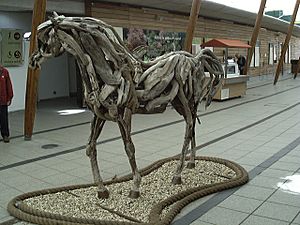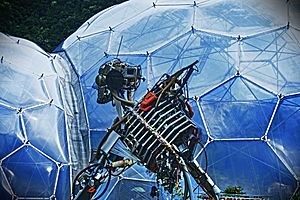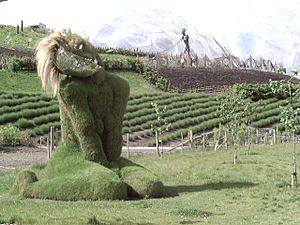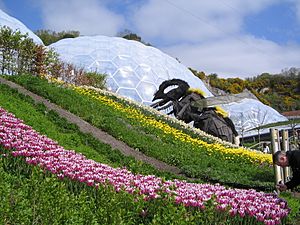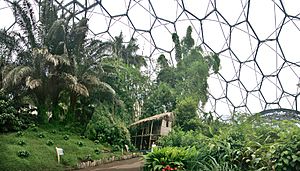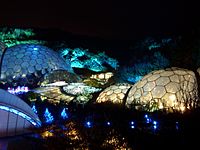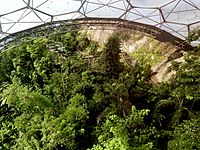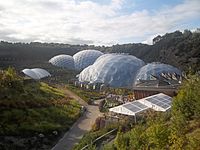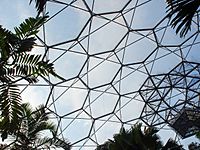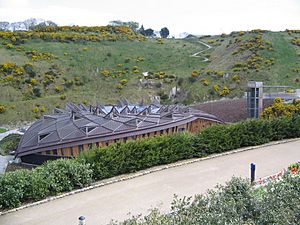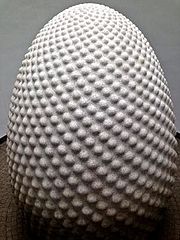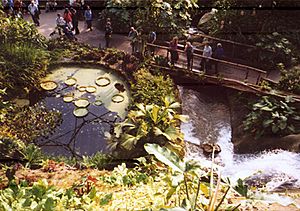Eden Project facts for kids
Quick facts for kids Eden Project |
|
|---|---|
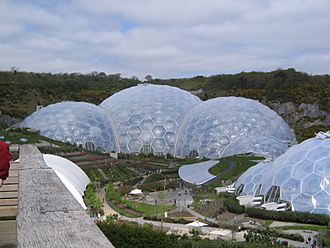 |
|
| General information | |
| Type | Multiple Greenhouse Complex |
| Architectural style | Inspired by James T. Baldwin's Pillow Dome |
| Location | St Blazey, Cornwall, UK |
| Coordinates | 50°21′43″N 4°44′41″W / 50.36194°N 4.74472°W |
| Completed | May 2000 |
| Opened | 17 March 2001 |
| Technical details | |
| Structural system | Steel frame and thermoplastic |
| Design and construction | |
| Architect | Grimshaw Architects |
| Structural engineer | Anthony Hunt and Associates |
| Services engineer | Arup |
The Eden Project (Cornish: Edenva) is a popular place to visit in Cornwall, England, UK. It is built in an old china clay pit. This pit is about 2 kilometers (1.2 miles) from St Blazey and 5 kilometers (3.1 miles) from St Austell.
The main part of the Eden Project has two huge areas with connected domes. These domes are home to thousands of different plant species. Each area is like a natural biome, which is a large natural habitat.
These biomes are made of hundreds of hexagonal and pentagonal panels. These panels are made from a special plastic called ETFE. They are filled with air and supported by Geodesic steel frames.
The biggest biome is like a rainforest. It is the largest indoor rainforest in the world! The second biome is like a Mediterranean area. The Eden Project also has outdoor botanical gardens. These gardens have many plants and wildlife found in Cornwall and the UK. They also show plants with interesting histories, like very old ones.
There are plans to build another Eden Project in Morecambe, Lancashire. This new project will focus on the ocean environment.
Contents
History of the Eden Project
The clay pit where the Eden Project now stands was used for over 160 years. By the mid-1990s, most of the clay had been dug out.
The idea for the Eden Project started in 1996. Building began in 1998. Heavy rain made the work difficult at first. Parts of the pit flooded because it is 15 meters (49 feet) below the water level.
The first part of the Eden Project, the visitor center, opened in May 2000. Plants started to arrive in September of that year. The whole site opened on 17 March 2001.
The Eden Project was a filming spot for the 2002 James Bond film, Die Another Day. On 2 July 2005, it hosted the "Africa Calling" concert. This was part of the Live 8 concert series.
Every winter, from November to February, the Project has "A Time of Gifts." This includes an ice rink over the lake and a Christmas market. Local choirs often sing in the biomes.
In 2012, the World Pasty Championships began to be held at the Eden Project. This is a competition to find the best Cornish pasties and other savory snacks.
The Eden Project has brought over £1 billion to the economy of Cornwall. In 2016, forty young Redwood trees were planted there. These trees could live for 4,000 years and grow very tall. This made it Europe's second largest Redwood forest.
In 2019, over 1 million people visited the Eden Project. In December 2020, the project closed for a while due to heavy rain.
How the Eden Project Was Built
The idea for the project came from Tim Smit. Grimshaw Architects designed it. Many other companies helped build it. These included Sir Robert McAlpine and Alfred McAlpine.
The company MERO designed and built the biomes. Arup helped with engineering and environmental plans. The project took two and a half years to build. It opened to visitors on 17 March 2001.
What You See at the Site
Layout of the Gardens
When you enter, there is a winding path. You can see the two biomes and planted gardens. There are also sculptures, like a giant bee. There used to be a tall figure called The WEEE Man. It was made from old electrical items. It showed how much electrical waste one person creates in a lifetime.
The Biomes
At the bottom of the pit are two large covered biomes:
- The Tropical Biome is very big. It covers about 1.56 hectares (3.85 acres). It is 55 meters (180 feet) high, 100 meters (328 feet) wide, and 200 meters (656 feet) long. This biome is home to tropical plants like bananas, coffee, and giant bamboo. It is kept warm and humid, like a real rainforest.
- The Mediterranean Biome is smaller. It covers about 0.654 hectares (1.62 acres). It is 35 meters (115 feet) high, 65 meters (213 feet) wide, and 135 meters (443 feet) long. This biome has plants from warm, dry areas. You can see olive trees, grape vines, and different sculptures.
The Outdoor Gardens show plants from temperate parts of the world. These include tea, lavender, hops, hemp, and sunflowers. You can also see plants that grow naturally in Cornwall.
The covered biomes are made of steel tubes. They have hexagonal panels on the outside. These panels are made from a plastic called ETFE. Glass was not used because it is too heavy and could be dangerous.
The ETFE panels are made of several layers of thin, clear film. These layers are sealed and filled with air to create a cushion. This cushion helps keep the heat inside. ETFE is easy to clean, as most dirt washes off in the rain. The structure stands on its own, like a geodesic dome. The panels are different sizes, with the largest ones at the top.
The Core Building
The Core is the newest building at the Eden Project. It opened in September 2005. It is an education center with classrooms and exhibition areas. It helps people learn about how plants and humans are connected.
The building's roof is made of timber and copper. Its shape is inspired by phyllotaxis. This is the mathematical pattern found in almost all plant growth. You can see it in sunflower seeds, pine cones, and pineapples.
Art at The Core
The Core also has art shows. A permanent sculpture called Seed is in the entrance room. Seed is a huge, egg-shaped stone that weighs 70 tonnes. It is about 13 feet (4 meters) tall. It has a complex pattern based on the mathematical rules that plants follow as they grow.
Protecting Our Environment
The biomes offer many different places for plants to grow. Many plants are shown, and their medicinal uses are explained.
The Eden Project teaches about how plants and people depend on each other. All the water needed for the humid Tropical Biome and for the toilets is rainwater. This water is collected at the bottom of the quarry and cleaned. Only water for hand washing and cooking comes from the main water supply. The project also uses "Green Tariff Electricity." This energy comes from wind turbines in Cornwall.
In 2010, the Eden Project got permission to build a geothermal electricity plant. This plant will use heat from deep underground to make electricity. It will produce enough power for the Eden Project and about 5,000 homes. Drilling for this project began in summer 2020.
Sir Tim Smit, a co-founder of Eden, said that the project has always dreamed of using renewable energy. He believes that heat from deep underground can provide power when the sun and wind are not available.
Other Eden Projects
Eden Project North
In 2018, the Eden Project shared plans for a new site in Morecambe, Lancashire. This new project will have buildings shaped like mussels. It will focus on the marine environment. It will also have gardens, performance areas, and observatories.
Grimshaw Architects are designing this project. It is expected to cost £80 million. This project is a partnership with local groups and universities. It is expected to create 500 jobs and attract many visitors.
South Downs
In 2020, there were talks about a new Eden site in the South Downs National Park.
Eden Sessions Concerts
Since 2002, the Eden Project has hosted music concerts called the Eden Sessions. Many famous artists have performed here. These include Amy Winehouse, Muse, Lily Allen, and Kylie Minogue.
The concerts were postponed in 2020 and 2021 due to the COVID-19 pandemic.
Past Performers
Some of the artists who have played at the Eden Sessions include:
- The Verve
- Kaiser Chiefs
- Jack Johnson
- Mumford & Sons
- Pendulum
- Blink-182
- Elton John
- Lionel Richie
- Massive Attack
- My Chemical Romance
Eden Project in the Media
The Eden Project has been featured in different media:
- The James Bond film Die Another Day used it as a filming location.
- The CBeebies TV show Andy's Aquatic Adventures filmed some scenes here.
Images for kids
See also
 In Spanish: Proyecto Edén para niños
In Spanish: Proyecto Edén para niños


